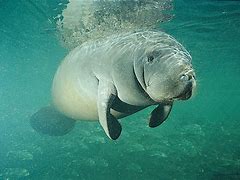
Manatee
Manatees are fascinating marine mammals known for their gentle nature and unique adaptations. Here are some interesting facts about manatees:
Species: Manatees belong to the order Sirenia, which includes three species: the West Indian manatee (Trichechus manatus), the Amazonian manatee (Trichechus inunguis), and the West African manatee (Trichechus senegalensis).
Aquatic Herbivores: Manatees are herbivorous, feeding primarily on aquatic plants such as seagrasses, algae, and freshwater vegetation. They are sometimes referred to as “sea cows” due to their grazing habits.
Size: Manatees are large animals, with adults reaching lengths of around 10 to 13 feet (3 to 4 meters) and weighing between 800 and 1,200 kilograms (1,800 to 2,600 pounds). The West Indian manatee is the largest of the three species.
Slow Movement: Manatees are not known for their speed. They are slow swimmers, usually moving at a leisurely pace of 3 to 5 miles per hour (5 to 8 kilometers per hour). However, they can briefly reach speeds of up to 15 miles per hour (24 kilometers per hour) when necessary.
Aquatic Adaptations: Manatees have several adaptations that allow them to thrive in aquatic environments. They have a thick, blubbery layer to provide buoyancy and insulation, paddle-like flippers for propulsion, and a broad, flat tail for steering.
Endothermic: Unlike most other aquatic mammals, manatees are endothermic or warm-blooded, meaning they can regulate their body temperature internally. This allows them to inhabit a wide range of warm and cool waters.
Slow Metabolism: To support their slow lifestyle and conserve energy, manatees have a slow metabolic rate. They have a relatively low heart rate of around 40 beats per minute, which can decrease further during extended dives.
Communication: Manatees are social animals and communicate with each other through a variety of vocalizations, including squeaks, chirps, and trills. They also communicate through body language, such as touching and nuzzling.
Conservation Status: Manatees face numerous threats, including habitat loss, boat collisions, entanglement in fishing gear, and pollution. As a result, they are considered vulnerable or endangered in their respective habitats. Conservation efforts are crucial for their survival.
Cultural Importance: Manatees have captured the attention and affection of people around the world. They are often seen as symbols of environmental conservation and have become popular tourist attractions in regions where they are found, such as Florida in the United States.